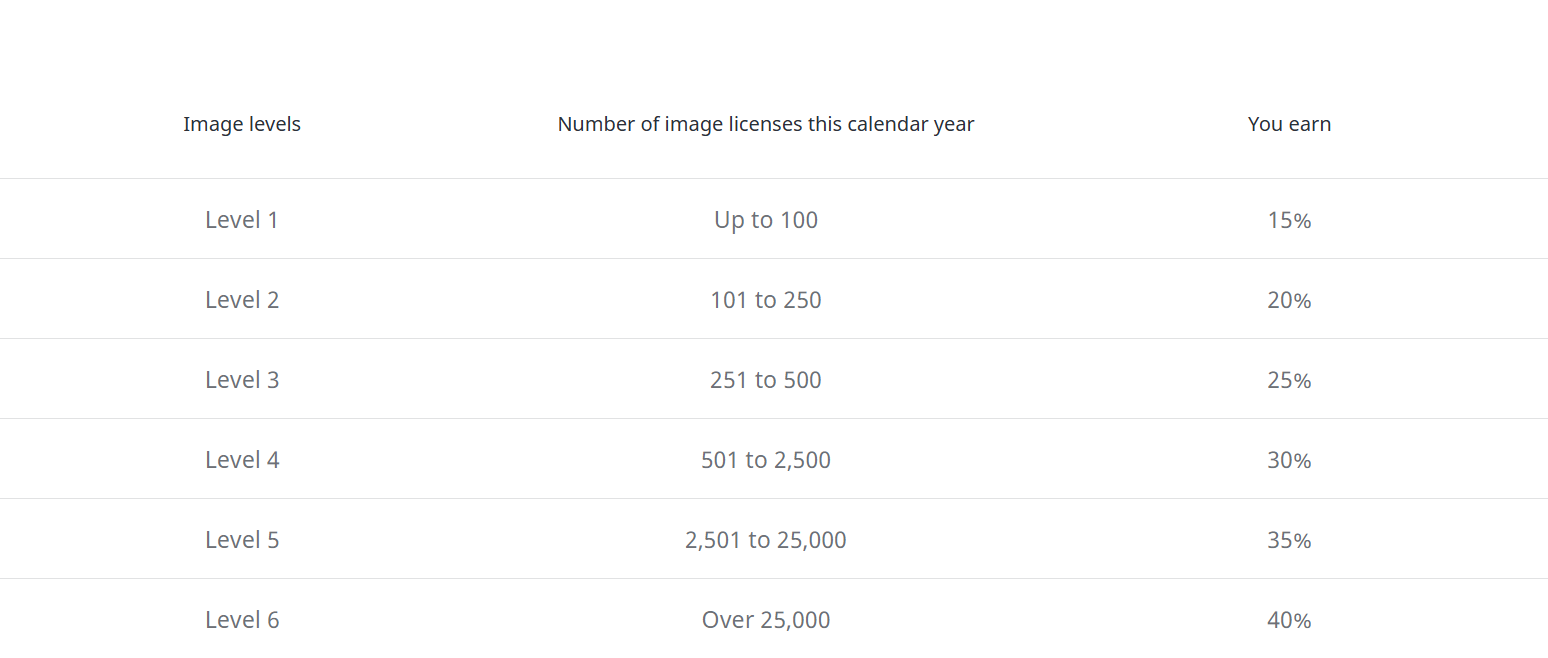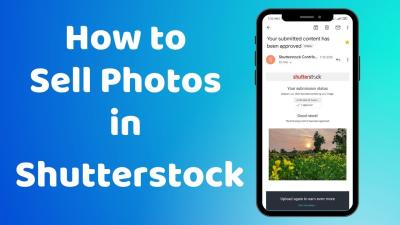If you’re passionate about photography, graphic design, or creating digital art, contributing to Shutterstock can be an exciting way to turn your creativity into income. But how exactly does Shutterstock pay its contributors? Understanding the ins and outs of their earning system helps you maximize your potential and ensure you’re getting paid fairly for your work. Whether you’re a seasoned contributor or just starting out, knowing how the platform rewards your efforts is key to building a successful portfolio and earning steady income from your talents.
How Shutterstock Tracks and Credits Your Content

Shutterstock has a pretty sophisticated system for tracking and crediting your contributions, which is essential to ensure you get paid accurately. When you upload your images, videos, or illustrations, each piece is assigned a unique identifier. These identifiers help Shutterstock keep tabs on where your content is being used and how often it’s downloaded.
Here’s a quick rundown of how the tracking process works:
- Unique Asset IDs: Every submission you upload gets a unique ID. This helps Shutterstock recognize your work across their platform.
- Metadata and Keywords: Properly tagging your content with relevant keywords and descriptions helps Shutterstock’s search algorithms find your work when customers are looking for specific visuals.
- Download and Sale Monitoring: Each time someone downloads or licenses your content, the system records this event, including details like the type of license purchased and the geographic location of the buyer.
- Royalty Calculation: Based on usage data, Shutterstock calculates your earnings according to their tiered royalty rates, which can vary depending on your contributor level and the type of license.
Shutterstock also provides contributors with dashboards and analytics tools so you can see real-time stats about your content’s performance. This transparency helps you understand which kinds of images or videos are most popular, so you can tailor your future uploads for better earnings.
Another important aspect is the review process. Shutterstock reviews new submissions to ensure they meet quality standards and are correctly attributed. Once approved, your content is actively tracked and credited whenever it’s accessed or licensed.
In short, Shutterstock‘s tracking system is designed to be thorough and transparent, making sure you’re credited properly and paid fairly for every download or license. Staying organized with your uploads, using relevant keywords, and monitoring your account regularly can help you make the most out of this platform and ensure your hard work pays off.
Payment Structure and Royalties for Shutterstock Contributors
Understanding how Shutterstock pays its contributors is key to maximizing your earnings and planning your creative journey. So, let’s break down the payment structure and how royalties work on this popular platform.
First off, Shutterstock operates on a royalty-based system. Basically, every time someone downloads one of your images, videos, or music tracks, you earn a royalty. The amount you receive depends on a few factors, including your contributor level, the type of content, and the licensing option chosen by the customer.
Contributor Levels: Shutterstock has different levels—Standard, Premium, and Exclusive. If you’re an exclusive contributor (meaning you only upload to Shutterstock), you typically earn higher royalties compared to non-exclusive contributors. Your level can also improve as you submit more content and hit certain milestones, which in turn boosts your earnings.
Here’s a quick overview of typical royalty rates:
- Standard License Downloads: Usually, contributors earn around 20-30% of the sale price.
- Enhanced License Downloads: These tend to pay slightly higher royalties, often around 30-40%, depending on your contributor level.
Keep in mind, the actual payout per download varies based on the content type—for example, photos generally earn less than videos, which typically command higher royalties. Also, the more you sell, the better your percentage can become, especially if you qualify for higher contributor levels.
Another important point is the concept of monthly earnings thresholds. Shutterstock has a minimum payout threshold (usually around $35), so you need to accumulate earnings to meet this before you can get paid. Once you reach that threshold, your earnings are processed according to the payout schedule.
In summary, your earnings on Shutterstock come from royalties paid per download, influenced by your contributor status, content type, and licensing. The platform rewards consistent contributions and exclusivity with better payout rates, making it worth considering how you want to position yourself as a creator.
Methods of Receiving Payments from Shutterstock
Now that you understand how you earn money on Shutterstock, let’s talk about how you actually get paid. Shutterstock offers several convenient payment methods, so you can choose what works best for you.
Here’s a rundown of the most common options:
| Payment Method | Details |
|---|---|
| PayPal | One of the most popular options. Just link your PayPal account to your Shutterstock account, and your earnings are transferred directly. Payments are typically processed on the 15th of each month, provided you’ve met the payout threshold. |
| Wire Transfer | Ideal for contributors who want direct bank deposits. This method might involve higher fees and is usually used for larger payouts or international contributors. |
| Payoneer | An alternative to PayPal, Payoneer offers a prepaid Mastercard and local bank transfer options in many countries. It’s a good choice if you prefer a dedicated card or local currency payouts. |
| Check | Less common these days, but still available for some contributors. You receive a physical check in the mail. Keep in mind, international shipping can take longer and may involve additional fees. |
Most contributors find PayPal to be the quickest and most straightforward method. To set up your preferred payout method, just go to your Shutterstock contributor dashboard, navigate to the payment settings, and link your accounts accordingly.
Another thing to note is that Shutterstock automatically withholds taxes for contributors in certain countries, especially if you’re a non-resident. Make sure to review your tax information in your account settings to ensure compliance and avoid delays.
Finally, remember that your payout is only processed once you hit the minimum threshold (usually $35). If your earnings are below that, they will roll over to the next month until you reach the payout minimum.
In a nutshell, Shutterstock offers flexible payment options to suit different needs, whether you prefer PayPal, bank transfers, or other methods. Setting up your payout method is simple, and once everything is in place, you’ll receive your earnings regularly—making it all the more rewarding to contribute your creative work!
Tips to Maximize Your Earnings on Shutterstock
So, you’re eager to boost your income from Shutterstock contributions? Great choice! The good news is, with a few smart strategies, you can increase your earnings and make your creative efforts more rewarding. Let’s dive into some practical tips that can help you get the most out of your Shutterstock portfolio.
Focus on Popular and Evergreen Topics
Understanding what buyers are searching for is key. Trends come and go, but certain themes stay relevant over time—think business, lifestyle, technology, nature, and health. Creating high-quality images and videos around these evergreen topics can lead to consistent sales.
Optimize Your Keywords and Titles
Keywords are the bridge between your content and potential buyers. Use accurate, descriptive, and relevant tags—think about what someone would type into the search bar to find your work. Also, craft clear titles that highlight the main subject. The better your keywords and titles, the higher the chances your content gets discovered.
Create Diverse Content
Offering a variety of media types—photos, videos, vectors—can attract different kinds of buyers. Plus, diversifying your portfolio increases your chances of making sales across multiple categories.
Upload Consistently
Regular uploads help you stay active and relevant on the platform. Shutterstock’s algorithm favors contributors who continually add fresh content, which can improve your visibility and sales potential over time.
Engage with the Community and Keep Learning
Stay updated on industry trends by engaging with other contributors, reading Shutterstock’s blogs, and participating in forums. The more you learn about what sells, the better you can tailor your submissions for maximum impact.
Leverage Trends and Seasonal Opportunities
Jump on seasonal themes—holidays, events, or trending topics—to capture timely demand. For example, creating high-quality images for Christmas or back-to-school seasons can give your earnings a nice boost.
Use High-Quality Equipment and Post-Processing
Invest in good cameras, lighting, and editing tools. Clear, sharp, and well-edited images or videos are more likely to sell. Remember, quality always wins over quantity.
Frequently Asked Questions About Shutterstock Payments
Curious about how Shutterstock pays contributors? You’re not alone! Here are some common questions answered to help you understand the ins and outs of earning from your contributions.
How often does Shutterstock pay?
Shutterstock typically processes payments monthly. Once you reach the minimum payout threshold (usually $35), you will receive your earnings via your chosen payment method, such as PayPal, Payoneer, or bank transfer. Keep in mind, processing times can vary depending on your location and payment provider.
What is the payout threshold?
The minimum payout amount is $35. If your earnings are below this threshold in a given month, they will roll over to the next month until you reach the minimum.
How are earnings calculated?
Your earnings depend on factors like the type of license purchased (standard or enhanced), your contributor level, and the buyer’s country. Shutterstock offers a revenue-sharing model, where you earn a percentage of the sale price. Typically, contributors earn around 30-40% of each sale, but this can vary based on your contributor level and other factors.
Are there any fees or deductions?
No, Shutterstock does not deduct any fees from your earnings. The amount you see as your payout is what you will receive, minus any applicable taxes or fees imposed by your payment provider.
Can I track my earnings?
Absolutely! Shutterstock provides a dashboard where you can monitor your earnings, sales, and download stats in real-time. This helps you understand which content performs best and plan your future uploads.
What happens if I don’t reach the payout threshold?
If your earnings don’t reach $35 in a given month, they will carry over to the next month. You’ll receive your payout once your balance surpasses the threshold.
Is there a way to increase my payout speed?
While you can’t directly speed up payouts, consistently uploading high-quality content, optimizing your keywords, and increasing your sales can help you reach the payout threshold faster. The more sales you generate, the quicker your earnings accumulate.
Understanding these payment basics can help you plan your contributions better and stay motivated as you grow your Shutterstock portfolio. Keep creating, keep learning, and soon you’ll see your efforts pay off!
Conclusion and Final Tips for Shutterstock Contributors
Contributing to Shutterstock can be a rewarding way to generate passive income while sharing your creativity with a global audience. To maximize your earnings and ensure a smooth experience, it’s essential to stay informed about the platform’s policies and best practices. Remember that high-quality, unique content tends to perform better and earns higher royalties. Keep an eye on your portfolio’s performance metrics to understand what types of images or videos resonate most with buyers. Regularly updating and diversifying your submissions can also boost your visibility and income potential.
Here are some final tips to help you succeed as a Shutterstock contributor:
- Maintain high quality: Use professional equipment and editing tools to produce sharp, well-lit, and properly composed content.
- Follow submission guidelines: Adhere to Shutterstock’s technical and model release requirements to avoid rejection.
- Research trends: Stay updated on popular themes and subjects to increase your content’s relevance and demand.
- Be consistent: Regular uploads keep your portfolio active and improve your chances of sales.
- Engage with the community: Participate in forums and read tutorials to learn from experienced contributors and improve your skills.
By applying these tips and maintaining dedication, you can build a successful portfolio on Shutterstock that provides a steady stream of income over time. Remember, persistence and continuous improvement are key to long-term success on the platform.


